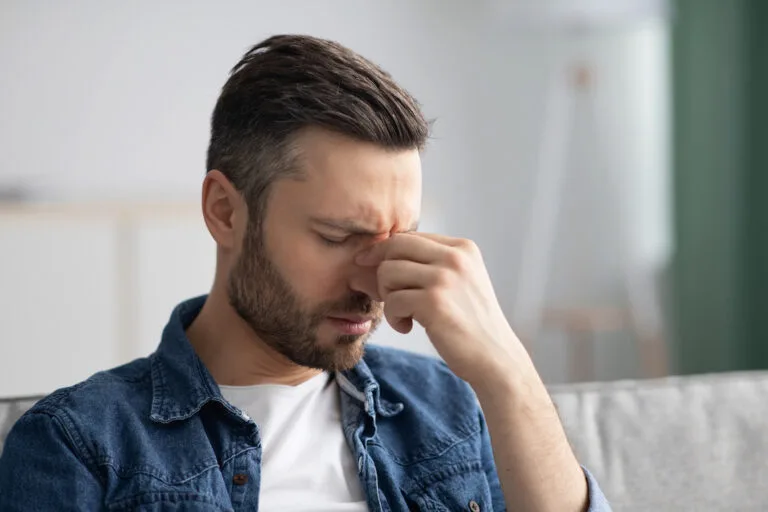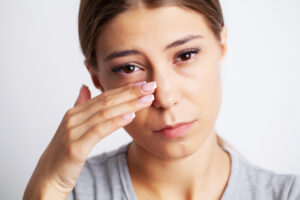Introduction
Sinus disease, characterized by inflammation and swelling of the sinus cavities, is a common condition that can cause a wide range of symptoms, including nasal congestion, facial pain, and difficulty breathing through the nose.
While sinus disease itself can be bothersome, it has also been associated with snoring and sleep apnea. A recent review article by papgianopolous et al looked at all the literature surrounding links between sleep and sinusitis.
In this blog, we will explore the relationship between sinus disease and these sleep-related issues, and discuss potential mechanisms and treatment options.
The Impact of Sinus Disease on Sleep:
Sinus disease can disrupt the normal airflow through the nasal passages, leading to a narrowed airway and subsequent breathing difficulties during sleep. This can result in two significant sleep-related problems: snoring and sleep apnea. Let’s understand these issues in more detail:
Snoring:
Snoring is on a continuum with sleep apnea. As we age there is a progressive weakening of the tube we breathe through usually mixed with a nasal obstruction. Nasal obstruction causes turbulent airflow in the upper airways. As the air passages become more floppy with age this turbulent airflow is instrumental in causing a fluttering noise as the airways begin to collapse.
In the case of sinus disease, the inflammation and congestion in the nasal passages can obstruct the airflow, forcing individuals to rely more heavily on mouth breathing. This change in breathing pattern increases the likelihood of snoring as the air passes through a narrower passage, causing vibrations in the soft tissues of the throat.
Sleep Apnea:
Sleep apnea is a sleep disorder in which breathing repeatedly stops and starts during sleep. It is the eventual result of the same forces that cause snoring. In other words, a progressive weakening of the upper airways usually mixed with nasal obstruction. There are three types of sleep apnea, with obstructive sleep apnea (OSA) being the most common (we will talk about central sleep apnea and other types in a future post).
Sinus disease can contribute to OSA by exacerbating nasal congestion, which further restricts the airflow. The narrow airway is more likely to collapse, causing interruptions in breathing, decreased oxygen levels, and disruptions in sleep patterns.
The Interplay Between Sinus Disease and Sleep Apnea:
Sinus disease and sleep apnea often intertwine and can aggravate one another in a vicious cycle. Here are some key factors to consider:
Chronic Inflammation: Sinus disease is frequently accompanied by chronic inflammation of the nasal passages, which can cause them to become excessively swollen. This inflammation can worsen snoring and obstructive events during sleep, leading to more significant disruptions in breathing.
Nasal Congestion: Congestion in the nasal passages can force individuals to breathe through their mouths, making them more prone to snoring and facilitating the occurrence of sleep apnea episodes. Additionally, mouth breathing can cause the airways to dry out, further compromising effective nighttime breathing.
Sleep Fragmentation: The interrupted sleep associated with sinus-related symptoms can disrupt the normal sleep architecture, leading to fragmented sleep patterns. This, in turn, increases the risk of sleep apnea episodes and shortens the duration of restorative sleep.
Managing Sinus Disease and Sleep-Related Issues:
Addressing sinus disease effectively can contribute to better management of snoring and sleep apnea. Remember: stuffy nights are BAD nights so its important we understand how to treat and manage all the causes of nasal congestion. Here are some measures that can help alleviate the symptoms and improve sleep quality:
Evaluation:
The symptoms of sinusitis are fairly nondescript unfortunately. Face pressure, nasal congestion and drainage are the most common and are shared by allergies. The best way to tell them apart is with a CT scan and a nasal endoscope. If the disease is primarily present within the sinuses then it is sinusitis. If the swelling and drainage are contained primarily within the nasal passage then allergy is suspected.
Antibiotics:
The first line therapy for bacterial sinusitis is antibiotics. There are many regimens that are considered first line therapy but the best antibiotic is the right one. Culture directed antibiotic therapy can be very effective way to treat bacterial sinusitis.
Nasal Irrigation:
Using a saline solution to flush out the nasal passages can help reduce congestion and minimize nasal inflammation. This can potentially improve nasal airflow and alleviate both snoring and sleep apnea symptoms. Topical medications can be added to the irrigations depending on the source.
Decongestants:
Nasal decongestant sprays or oral decongestants can provide temporary relief by reducing nasal swelling. However, prolonged use may lead to dependence, so it is essential to follow the instructions and consult a healthcare professional if symptoms persist.
Allergen Management:
For individuals whose sinus disease is triggered or exacerbated by allergies, identifying and managing allergens can be crucial. This may involve avoiding known allergens, using allergy-proof bedding, and considering medication or immunotherapy under medical supervision.
Continuous Positive Airway Pressure (CPAP) Therapy:
For individuals with moderate to severe sleep apnea, CPAP therapy may be recommended. A CPAP machine helps maintain a constant airflow during sleep, keeping the airways open and preventing pauses in breathing. Proper mask fit and adjustment to pressure levels are essential for optimal treatment.
Conclusion
The take home message is that stuffy nights are bad nights!! In other words, sinus disease can significantly impact sleep quality and contribute to snoring and sleep apnea symptoms. The inflammation and congestion associated with sinus disease can lead to nasal obstruction, mouth breathing, and disrupted sleep patterns.
Recognizing the relationship between sinus disease and sleep-related issues is crucial for implementing effective management strategies. Seeking medical advice, proper treatment of sinus disease, and exploring options such as nasal irrigation, decongestants, and CPAP therapy can help improve breathing, reduce snoring, and alleviate sleep apnea symptoms, leading to better overall sleep quality and well-being.





